|
 Marasmius otagensis Marasmius otagensis
BiostatusPresent in region - Indigenous. Endemic
Images (click to enlarge) | 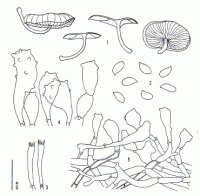
Caption: Fig. 18 (1-5). Marasmius otagoensis G. Stevenson (ZT 69-12).- 1. Basidiomes.- 2. Basidio-spores.- 3.
Basidia.- 4. Cheilocystidia.- 5. Pileipellis. | 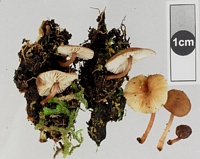
Owner: J.A. Cooper | 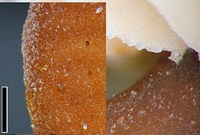
Caption: scale=0.5mm. Left cap edge. Right gill atachment and stem.
Owner: J.A. Cooper | 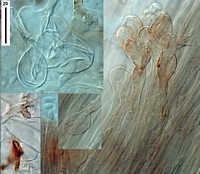
Caption: left upper: hymeniderm, thick walled cap cells. Left lower: occasional pigmented short fingers on sub-epidermal hyphae - here encrusted with pigment. right: inflated caulocystidia with pigment.
Owner: J.A. Cooper | 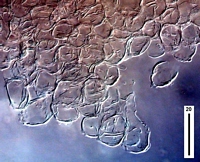
Caption: cheilocystidia.
Owner: J.A. Cooper |
Article: Stevenson, G. (1964). The Agaricales of New Zealand: V. Kew Bulletin 19(1): 1-59.
Description: Pileus 1.5-2.2 cm diam., pinkish fawn with darker radial striations, plano-convex with a broad shallow umbilicus, smooth, dull; flesh thin, fawn. Gills adnate, creamy, moderately distant. Stipe 10-15 x 1-2 mm, reddish brown, tapering to base, tough. Spores 7-10 x 3 µm, non-amyloid, thin-walled. Hymenophoral trama non-amyloid with some thick-walled hyphae. Cuticle cellular, weakly pseudo-amyloid.
Habitat: In forest litter, Woodside, 1.7.1953, M. Morrison in Stevenson (type).
Article: Desjardin, D.E.; Horak, E. (1997). Marasmius and Gloiocephala in the South Pacific Region: Papua New Guinea, New Caledonia, and New Zealand taxa. Bibliotheca Mycologica 168: 152 p.
Description: Pi1eus 10-35 mm diam, convex when young, expanding with age to planoconvex with a flat to
depressed disc; margin conspicuously striate to plicate, incurved; surface dull, dry, minutely
pruinose to fibrillose; dark brown to pale reddish brown overall when young, sometimes with a
yellowish brown tone, fading in age or with moisture loss to pinkish fawn. Texture
membranaceous, tough; context thin, white.- Lamellae broadly adnate to subdecurrent, subdistant
(16-20) with 2-3 series of lamellulae, broad (up to 3.5 mm), cream to apricot or pale reddish
brown; edges fimbriate, concolorous.- Stipe7-30 x 1-2 mm, central or occasionally eccentric,
cylindrical, equal or with a flared apex, curved, fistulose, tough, apex minutely pruinose, glabrous
elsewhere, insititious; pale reddish brown to dark reddish brown or black overall; rhizomorphs
absent.- Odor and taste not distinctive.
Basidiospores 4.0-5.5(-6.5) x 2.0-3.0 µm, ellipsoid, smooth, thin-walled, hyaline, inamyloid-.
Basidia 20-35 x 4-5 µm, cylindrical to subclavate, 4-spored, clamped.- Cheilocystidia abundant, 20-40(-50) x 818(-24) µm, clavate to broadly clavate or irregular in outline, hyaline, thin-walled, with
few, scattered, apical knob-like diverticula, 1-4 x 1-3 µm.Pleurocystidia absent.- Pileipellis
subhymeniform over the disc, a cutis towards the margin; terminal cells 20-50 x 10-26 µm , clavate
to irregular in outline, erect, suberect or repent, diverticulate, hyaline, thin-walled, inamyloid;
diverticula 1-4 x 1-3 µm , knob-like, hyaline.- Pi1ea1 trama of loosely interwoven hyphae; hyphae
cylindrical to sinous, non-gelatinized, hya line, inamyloid, very thick-walled, some with nearly no
lumen.- Stipe tissue monomitic; cortical hyphae cylindrical, roughened or with short diverticula,
thin-walled, dextrinoid; medullary hyphae, thin-walled to thick-walled, dextrinoid.- Cau1ocystidia
25-55 x 7-16 µm, polymorphic, similar to cheilocystidia, rare at stipe apex, clavate to
sphaeropedunculate, hyaline, thinwalled to moderately thick-walled.
Habitat: Habit, habitat and distribution.- Solitary, ingroups on mossy bark of Nothofagus spp. (N. fucua, N.
menziesii; Fagaceae) or Weinmannia racemosa (Cunoniaceae). New Zealand.
Notes: Marasmius otagoensis has the aspect and coriaceous texture of a Micromphale species, but the
non-gelatinized tramal tissues, subhymeniform pileipellis with clavate terminal cells and scattered
diverticula, and dextrinoid stipe tissues indicate placement in Marasmius sect. Androsacei.
Stevenson (1964) reported the basidiospores as measuring 7-10 x 3 µm . Our analysis of the
holotype specimen indicate that the basidiospores are much smaller, measuring 4.5-6.5 x 2.0-2.5 µm
, with only a few longer spores (up to 9.0 µm) possibly from 2-spored basidia. The species is fairly
common growing on moss covered bark of Nothofagus.
|